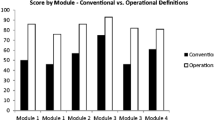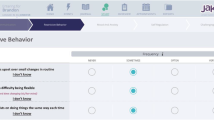Abstract
An observational coding system was developed to track clinical change in children with autism spectrum disorder (ASD) during psychotherapy. The Pediatric Autism Spectrum Therapy Observation System (PASTOS) consists of 23 items divided into 5 subscales and is used to rate child behaviors in individual psychotherapy sessions. Manual-based cognitive behavioral therapy session transcripts of 22 children diagnosed with ASD (IQ > 70) and a concurrent anxiety disorder (M = 9.41 years, SD = 1.56 years) enrolled in a randomized, controlled trial were coded. Results suggested that the PASTOS exhibited promising interrater reliability, internal consistency, convergent validity at post-treatment, and treatment sensitivity. The PASTOS may be a useful tool for studying process and outcome in psychotherapy research on children with ASD.
Similar content being viewed by others
References
Anagnostou E, Jones N, Huerta M, Halladay AK, Wang P, Scahill L et al (2015) Measuring social communication behaviors as a treatment endpoint in individuals with autism spectrum disorder. Autism 19(5):622–636
Angarita BN, Kolevzon A (2017) Autism spectrum disorder. Mt. Sinai Expert Guides. https://doi.org/10.1002/9781118654231.ch25
Baio J, Wiggins L, Christensen DL, Maenner MJ, Daniels J, Warren Z et al (2018) Prevalence of autism spectrum disorder among children aged 8 years: autism and developmental disabilities monitoring network, 11 Sites, United States, 2014. MMWR Surv Sum 67(6):1–23. https://doi.org/10.15585/mmwr.ss6706a1
Bellini S (2004) Social skills deficits and anxiety in high-functioning adolescents with autism spectrum disorders. Focus Autism Other Dev Disabil 19(2):78–86
Cicchetti DV (1994) Guidelines, criteria, and rules of thumb for evaluating normed and standardized assessment instruments in psychology. Psychol Assess 6(4):284–290
Constantino JN, Gruber CP (2005) The social responsiveness scale (SRS) manual. Western Psychological Services, Los Angeles
Danial JT, Wood JJ (2013) Cognitive behavioral therapy for children with autism: review and considerations for future research. J Dev Behav Pediatr 34(9):702–715
Davis NO, Carter AS (2008) Parenting stress in mothers and fathers of toddlers with autism spectrum disorders: associations with child characteristics. J Autism Dev Disord 38(7):1278
de Bruin EI, Ferdinand RF, Meester S, de Nijs PFA, Verheij F (2007) High rates of psychiatric co-morbidity in PDD-NOS. J Autism Dev Disord 37:877–886
De Los Reyes A, Alfano CA, Beidel DC (2010) The relations among measurements of informant discrepancies within a multisite trial of treatments for childhood social phobia. J Abnorm Child Psychol 38(3):395–404
Drahota A, Wood JJ, Sze K, Van Dyke M (2011) Effects of cognitive behavioral therapy on daily living skills in children with high-functioning autism and concurrent anxiety disorders. J Autism Dev Disord 41:257–268
Elkin I, Pilkonis P, Docherty J, Sotsky S (1988) Conceptual and methodological issues in comparative studies of psychotherapy and pharmacotherapy: I active ingredients and mechanisms of change. Am J Psychiatry 145:909–917
Gardner F, Burton J, Klimes I (2006) Randomized controlled trial of a parenting intervention for reducing child conduct problems: outcomes and mechanisms of change. J Child Psychol Psychiatry 47(11):1123–1132
Gresham FM, Elliot SN (1990) The social skills rating system. American Guidance Services, Circle Pines
Gresham FM, Elliott SN, Cook CR, Vance MJ, Kettler R (2010) Cross-informant agreement for ratings for social skill and problem behavior ratings: an investigation of the social skills improvement system—rating scales. Psychol Assess 22(1):157
Guy W (1976) Clinical global impressions. ECDEU Assessment manual for psychopharmacology (Vol. Review DHEW pub. (ADM)). National Institute for Mental Health, Rockville, pp 218–222
Hill CE, O’grady KE, Elkin I (1992) Applying the Collaborative Study Psychotherapy Rating Scale to rate therapist adherence in cognitive-behavior therapy, interpersonal therapy, and clinical management. J Consult Clin Psychol 60(1):73
Hogue A, Liddle HA, Rowe C (1996) Treatmentadherenceprocess researchinfamilytherapy:arationaleandsomepracticalguidelines. Psychotherapy 33(2):332–345
Kerns C, Renno P, Storch EA, Kendall P, Wood JJ (2017) Anxiety in children and adolescents with autism spectrum disorder. Academic Press, New York
Klin A, Pauls D, Schultz R, Volkmar F (2005) Three diagnostic approaches to Asperger Syndrome: implications for research. J Autism Dev Disord 35:221–234
Lecavalier L, Wood JJ, Halladay AK, Jones NE, Aman MG, Cook EH et al (2014) Measuring anxiety as a treatment endpoint in youth with autism spectrum disorder. J Autism Dev Disord 44(5):1128–1143
Le Couteur A, Lord C, Rutter M (2003) The autism diagnostic interview-revised. Western Psychological Services, Los Angeles
Lerner MD, Calhoun CD, Mikami AY, De Los Reyes A (2012) Understanding parent–child social informant discrepancy in youth with high functioning autism spectrum disorders. J Autism Dev Disord 42(12):2680–2692
Leyfer OT, Folstein SE, Bacalman S, Davis NO, Dinh E et al (2006) Comorbid psychiatric disorders in children with autism: interview development and rates of disorders. J Autism Dev Disord 36(7):849–861
Lord C, Rutter M, DeLavore PC, Risi S (1999) Autism diagnostic observation schedule. Western Psychological Services, Los Angeles
Margolin G, Oliver P, Gordis E, O’Hearn H, Medina A, Ghosh C, Morland L (1998) The nuts and bolts of marital and family interaction. Clin Child Fam Psychol Rev 1(4):195–213
March JS (1998) Multidimensional anxiety scale for children. Multi-Health Systems, North Tonawanda
March JS, Parker JD, Sullivan K, Stallings P, Conners CK (1997) The Multidimensional Anxiety Scale for Children (MASC): factor structure, reliability, and validity. J Am Acad Child Adolesc Psychiatry 36(4):554–565
McLeod BD, Weisz JR (2010) The therapy process observational coding system for child psychotherapy strategies scale. J Clin Child Adolesc Psychol 39:436–443
McMahon CM, Solomon M (2015) Brief report: Parent–adolescent informant discrepancies of social skill importance and social skill engagement for higher-functioning adolescents with autism spectrum disorder. J Autism Dev Disord 45(10):3396–3403
Muris P (2001) A brief questionnaire for measuring self-efficacy in youths. J Psychopathol Behav Assess 23:145–149
Ozonoff S, Iosif AM, Young GS, Hepburn S, Thompson M, Colombi C et al (2011) Onset patterns in autism: correspondence between home video and parent report. J Am Acad Child Adolesc Psychiatry 50(8):796–806
Patterson GR, Chamberlain P (1994) A functional analysis of resistance during parent training therapy. Clin Psychol Sci Pract 1(1):53–70
Pedersen JA, Worrell FC, French JL (2001) Reliability of the social skills rating system with rural Appalachian children from families with low incomes. J Psychoedu Assess 19(1):45–53
Rosenthal R, Rosnow RL (1984) Essentials of behavioral research: methods and data analysis. McGraw-Hill, New York
Rutter M, Le Couteur A, Lord C (2003) Autism diagnostic interview-revised. Western Psychological Services, Los Angeles
Scahill L, Riddle MA, McSwiggin-Hardin M, Ort SI, King RA, Goodman WK et al (1997) Children's Yale-Brown obsessive compulsive scale: reliability and validity. J Am Acad Child Adolesc Psychiatry 36(6):844–852
Shapiro D, Startup M (2010) Measuring therapist adherence in exploratory psychotherapy. Psychother Res 2(3):193–203
Shrout PE, Fleiss JL (1979) Intraclass correlations: uses in assessing rater reliability. Psychol Bull 86(2):420
Silverman WK, Albano AM (1996) The anxiety disorders interview schedule for DSM-IV-child and parent versions. Graywinds, San Antonio
Simonoff E, Pickles A, Charman T, Chandler S, Loucas T, Baird G (2008) Psychiatric disorders in children with autism spectrum disorders: prevalence, comorbidity, and associated factors in a population-derived sample. J Am Acad Child Adolesc Psychiatry 47(8):921–929
Sparrow S, Balla D, Cicchetti D (1984) Vineland scales of adaptive behavior: survey form manual. American Guidance Service, Circle Pines
Storch EA, Ehrenreich May J, Wood JJ, Jones AM, De Nadai AS, Lewin AB et al (2012) Multiple informant agreement on the anxiety disorders interview schedule in youth with autism spectrum disorders. J Child Adolesc Psychopharmacol 22(4):292–299
Storch EA, Larson MJ, Ehrenreich-May J, Arnold EB, Jones AM, Renno P, Fujii C, Lewin AB, Mutch PJ, Murphy TK, Wood JJ (2012) Peer victimization in youth with autism spectrum disorders and co-occurring anxiety: relations with psychopathology and loneliness. J Dev Phys Disabil 24(6):575–590
Sukhodolsky DG, Scahill L, Gadow KD, Arnold LE, Aman MG et al (2008) Parent-rated anxiety symptoms in children with pervasive developmental disorders: frequency and association with autism symptoms and cognitive functioning. J Abnorm Child Psychol 36(1):117–128
Treadwell KR, Kendall PC (1996) Self-talk in youth with anxiety disorders: states of mind, content specificity, and treatment outcome. J Consult Clin Psychol 64(5):941–950
Ung D, Wood JJ, Ehrenreich-May J, Arnold EB, Fujii C, Renno S (2013) Clinical characteristics of high-functioning youth with autism spectrum disorder and anxiety. Neuropsychiatry. https://doi.org/10.2217/npy.13.9
Van Steensel FJA, Bogels S, de Bruin EI (2013) Psychiatric comorbidity in children with autism spectrum disorders: a comparison with children with ADHD. J Child Fam Stud 22(3):368–376
Waltz J, Addis ME, Koerner K, Jacobson NS (1993) Testing the integrity of a psychotherapy protocol: assessment of adherence and competence. J Consult Clin Psychol 61(4):620–630
Webb CA, DeRubeis RJ, Barber JP (2010) Therapist adherence/competence and treatment outcome: a meta-analytic review. J Consult Clin Psychol 78(2):200–211
Weisz JR, Chorpita BF, Frye A, Ng MY, Lau N, Bearman SK, Hoagwood KE (2011) Youth top problems: using idiographic, consumer-guided assessment to identify treatment needs and to track change during psychotherapy. J Consult Clin Psychol 79(3):369
White S, Ollendick T, Scahill L, Oswald D, Albano AM (2009) Preliminary efficacy of a cognitive-behavioral treatment program for anxious youth with autism spectrum disorders. J Autism Dev Disord 39(12):1652–1662
Wood JJ, Drahota A, Sze K, Har K, Chiu A, Langer DA (2009) Cognitive behavioral therapy for anxiety in children with autism spectrum disorders: a randomized, controlled trial. J Child Psychol Psychiatry 50(3):224–234
Wood JJ, Drahota A, Sze KM, Van Dyke M, Decker K, Fujii C, Bahng C, Renno P, Hwang WC, Spiker M (2009) Brief report: effects of cognitive behavioral therapy on parent-reported autism symptoms in school-age children with high-functioning autism. J Autism Dev Disord 39:1608–1612
Wood JJ, Gadow KD (2010) Exploring the nature and function of anxiety in youth with autism spectrum disorders. Clin Psychol Sci Pract 17(4):281–292
Wood JJ, Kendall PC, Wood KS, Kerns C, Seltzer M, Small BJ, Lewin AB, Storch EA (2019) Cognitive behavioral treatments for anxiety in youth with autism spectrum disorder: a randomized clinical trial. JAMA 20:217–238
Wood JJ, McLeod B, Piacentini JC, Sigman M (2009) One-year follow-up of family versus child CBT for anxiety disorders: exploring the roles of child age and parental intrusiveness. Child Psychiatry Hum Dev 40:301–316
Woolley SR, Butler MH, Wampler KS (2000) Unraveling change in therapy: three different process research methodologies. Am J Family Therapy 28(4):311–327
Funding
This study was funded by a Treatment-Related Grant from Cure Autism Now (now Autism Speaks). Work on this paper was also supported by National Institute of Mental Health Grant R01-MH094391.
Author information
Authors and Affiliations
Corresponding author
Ethics declarations
Ethical Approval
All procedures performed in studies involving human participants were in accordance with the ethical standards of the institutional and/or national research committee and with the 1964 Helsinki declaration and its later amendments or comparable ethical standards.
Informed Consent
Informed consent was obtained from all individual participants included in the study.
Additional information
Publisher's Note
Springer Nature remains neutral with regard to jurisdictional claims in published maps and institutional affiliations.
Rights and permissions
About this article
Cite this article
Van Dyke, M.V., Guevara, M.V.C., Wood, K.S. et al. The Pediatric Autism Spectrum Therapy Observation System: Development, Psychometric Properties, and Sensitivity to Treatment. Child Psychiatry Hum Dev 52, 1143–1153 (2021). https://doi.org/10.1007/s10578-020-01068-4
Accepted:
Published:
Issue Date:
DOI: https://doi.org/10.1007/s10578-020-01068-4




